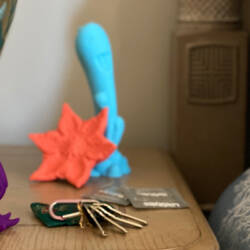Sweet Nothings: How Technology Is Changing Our Love Languages
As with most things, how we communicate continues to evolve

“The limits of my language means the limits of my world.” -Ludwig Wittgenstein
There’s always been an unspoken vocabulary of caresses, glances, and sounds, of course. But we’re in the 21st century now, and our technological options for expressing desire—over vast distances and across what used to be cultural barriers—has (to use a silly double-entendre) swelled incredibly.
We don’t just have new ways to correspond with each other but entirely new languages to play with. Lovers, or just playmates, can flirt, be titillating, or even directly stimulate each other speaking or typing a single word.
So, with a touch of irony, here’s a list of four ways that technology is changing the language of love and desire, but also how the nature of sexual communication is being totally reinvented.
Sexting slang

Slang, saying a lot in little time and space, has been around for a long time. But it took computers and smartphones, via texting and instant messaging (IM), for it to not just become ubiquitous but also to evolve into a kind of artform—especially a covert one.
At first writing things like TDTM (talk dirty to me) was just easier. But then people—and here’s where the finger gets mostly pointed at young people discovered that occasionally others might be looking over their shoulders and seeing what they’re writing. So acronyms became something of a secret code.
Experts can easily hold entire conversations in shorthand: KFY (kiss for you), IWSN (I want sex now), and then, hopefully, LMIRL (let’s meet in real life) or, alas, LOL.
Occasionally it hits a snag when the receiver ends up scratching their head trying to figure a new acronym out. But text shorthand is quick, simple, and straightforward—and perfect for flirting or even propositioning. A large part of this is because there’s a kind of safe separation using an acronym. Saying to a playmate that they are NIFOC is a lot more comfortable than actually typing out “nude in front of computer.”
Emojis

That snag of needing to know the code, what the acronym exactly stands for, doesn’t happen when you’re communicating with emojis. This makes the little pictographic communications medium really handy to flirt beyond written language. Putting in an emoji for a kiss is always a kiss no matter if the sender is French or Japanese.
That safe, comfortable separation is here, too, and it’s also a timesaver in this fast-paced world we now live in. Sending “I’m excited! Kiss, kiss, kiss, and much lust” takes a lot more of our valuable time than just sending the appropriate symbols.
There’s also a kind of innate playfulness to using symbols. Lovers often will just send a single heart, or kiss, or any of the other 1,620 out there (and that’s just in iOS).
Another flavor of emoji is what could be described as an animated version: avatars. For many people using virtual environments like Second Life, and the many adult flavors, communicating without a voice has become as natural as speaking their native tongue.
In these artificial places, flirting and sex chat can take place with both shorthand and emojis as well as animations by avatars themselves. Someone coming on too strong? Then just trigger a polite head shake for your virtual alter-ego. Interested? Crook a finger in their direction with a click of a mouse.
Behind virtually closed doors, there’s even a special kind of erotic language: one where misspellings, clumsy grammar, or just randomly hitting keys in a chat window can mean someone’s having a very good time—and is typing one handed.
Artificial intelligence

Then there’s a very different form of alternative reality. Artificial Intelligence has come a long way since ELIZA first tried to convince us that she wasn’t just some computer code. Soon it’s going to be very tough to tell who—or what—you may be flirting with.
Robotics expert David Levy, for instance, is working on Erotic Chatbots Ltd, which could be a leap forward in responsive and adaptable artificial intelligence. The possibilities for technology like his are intriguing, and not just because of the potential of a lifelike digital lover.
While there are some who see a danger in chatbots perhaps supplanting, or just overshadowing, human beings, others see the possibilities as far more positive. For those dealing with a wide range of emotional concerns, for example, to be able to talk to someone who won’t judge, get distracted, and who could even guide the conversation towards positive goals could be a real lifesaver.
For others who just want a good time, a chatbot could also be a fun way to interact with a sexual partner who knows just what to say and when, and—when coupled with an avatar—how to virtually do it as well.
Haptic tech and remote sex devices

The last of our four changes to erotic communication is possibly the purest form: no words at all. Recently there has been more than a few huge developments in connecting sex tech gear.
Companies like Kiiroo, with its Pearl (for women) and Onyx (for men) devices, and OhMiBod with its OH-DOMETER linking app and other remote devices, have opened the door for the arrival of true teledildonics. With this current technology, lovers can trigger vibrators and other devices remotely or pre-program patterns of stimulation.
And greater innovations are right around the corner; ones that may very well create a near-perfect illusion of sexual reality. The Telsasuit, for instance, offers the promise of a full body virtual sensation. Using “smart textiles” the suit allows the wearer to receive—at present—a virtual hug via electromagnetic pulses. Though there’s no reason to doubt that the technology can also be brought to every other part of the body (wink wink).
When fully developed, this technology could very well mean the end of needing to wear physical haptic technology: allowing users to not just see their sexual partner remotely but touch and be touched.
All without a word being spoken: the physical language of love reaching anyone, and anywhere, in almost an instant.
The word is sex

Humans have an innate need to connect with one another: intellectually, emotionally, and, especially, sexually. Evolved to help us in these pursuits, communication–helped by technology–has given us more and more ways of connecting.
Right now we can express a wide range of emotion, and desire, with linguistic shorthand, symbols, and even physical contact. Who knows, eventually technology may very well give us perfect communication: the ability to link mind to mind, directly.
Until then, we’ll continue to push the limit of not just how we express sexual pleasure but the very definition of what sex can be.
Image Sources: Depositphotos
Leave a reply
You must be logged in to post a comment.
















